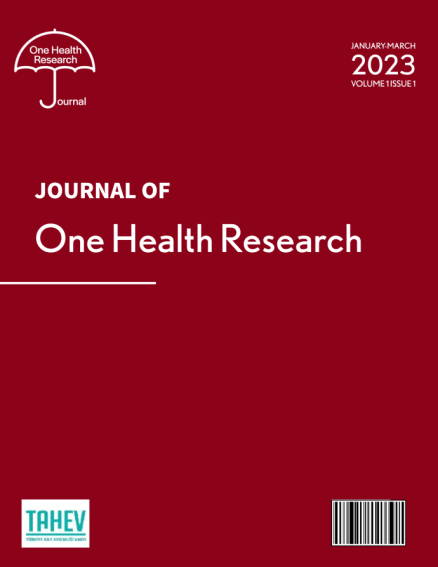The Effect of Angiotensin Converting Enzyme Inhibitor Therapy on Electrocardiographic Parameters and QT Dispersion in Left Heart Failure
DOI:
https://doi.org/10.5281/zenodo.10971114Keywords:
QT dispersiyon, sol kalp yetmezliği, ACE inhibitörüAbstract
Background: Changes in electrocardiographic (ECG) parameters, such as QT intervals and RR intervals, have been hypothesized to correlate with an elevated mortality risk among heart failure patients. The objective of our study was to examine the immediate effects of angiotensin-converting enzyme (ACE) inhibitor utilization on QT dispersion (QTd) and other ECG parameters in individuals diagnosed with left heart failure.
Methods: A total of forty-one patients diagnosed with heart failure and prescribed enalapril 10 mg at the cardiology outpatient clinic during the period of August to October 1999 were included in this evaluation. Out of these, twenty-six patients who met the criteria for ECG measurements were enrolled in the study. At the beginning of the study, 12-lead ECG and echocardiography measurements were obtained, while 12-lead ECG measurements were taken again at the 6th week of treatment. Additional ECG parameters, such as QTd, QT max, QTc max, and RRCV, were derived from the ECG data of the patients. The values at baseline and week 6 were then compared.
Results: Twenty-six patients exhibited baseline values for QT max, QTc max, RRCV, and QTd of 381.9±30.47 msec, 476.3±31.2 msec1/2, 4.72±3.15, and 56.9±16.7 msec, respectively. These values were evaluated after six weeks of enalapril treatment, yielding measurements of 383.5±36.33 msec, 470.2±30.7 msec1/2, 4.96±2.94, and 51.5±27.8 msec, respectively. No significant differences were observed in these four parameters before and after treatment. However, among the subgroup of patients with a baseline QTd ≥ 50 msec (n=21), the initial QTd value measured 63.3±11.1 msec, whereas the QTd value after six weeks was 50.5±24.4 msec (p=0.032).
Conclusion: In individuals diagnosed with heart failure, the utilization of enalapril did not result in a substantial alteration in electrocardiogram (ECG) parameters, particularly the corrected QT interval dispersion (QTd), over a brief duration of time. However, among patients exhibiting a baseline QTd interval exceeding 50 milliseconds, a significant reduction in QTd was observed following a 6-week administration of enalapril.
References
Cohn JN, Johnson G, Ziesche S, et al. A comparison of enalapril with hydralazine–isosorbide dinitrate in the treatment of chronic congestive heart failure. New England Journal of Medicine. 1991;325(5):303-310.
Investigators* S. Effect of enalapril on survival in patients with reduced left ventricular ejection fractions and congestive heart failure. New England Journal of Medicine. 1991;325(5):293-302.
Higham P, Campbell R. QT dispersion. British heart journal. 1994;71(6):508.
Day CP, McComb JM, Campbell R. QT dispersion: an indication of arrhythmia risk in patients with long QT intervals. Heart. 1990;63(6):342-344.
Janse MJ, Wit AL. Electrophysiological mechanisms of ventricular arrhythmias resulting from myocardial ischemia and infarction. Physiological reviews. 1989;69(4):1049-1169.
Kautzner J, Malik M. QT interval dispersion and its clinical utility. Pacing and Clinical Electrophysiology. 1997;20(10):2625-2640.
Galinier M, Vialette J-C, Fourcade J, et al. QT interval dispersion as a predictor of arrhythmic events in congestive heart failure: importance of aetiology. European heart journal. 1998;19(7):1054-1062.
Barr CS, Naas A, Freeman M, Lang CC, Struthers AD. QT dispersion and sudden unexpected death in chronic heart failure. The Lancet. 1994;343(8893):327-329.
Grimm W, Steder U, Menz V, Hoffmann J, Maisch B. QT dispersion and arrhythmic events in idiopathic dilated cardiomyopathy. The American journal of cardiology. 1996;78(4):458-461.
Tamura A, Nagase K, Mikuriya Y, Nasu M. Relation of QT dispersion to infarct size and left ventricular wall motion in anterior wall acute myocardial infarction. The American journal of cardiology. 1999;83(10):1423-1426.
Malik M, Camm AJ. Mystery of QTc interval dispersion. American Journal of Cardiology. 1997;79(6):785-787.
Elming H, Holm E, Jun L, et al. The prognostic value of the QT interval and QT interval dispersion in all-cause and cardiac mortality and morbidity in a population of Danish citizens. European heart journal. 1998;19(9):1391-1400.
Goldberg RJ, Bengtson J, Chen Z, Anderson KM, Locati E, Levy D. Duration of the QT interval and total and cardiovascular mortality in healthy persons (The Framingham Heart Study experience). American Journal of Cardiology. 1991;67(1):55-58.
Pye M, Quinn A, Cobbe S. QT interval dispersion: a non-invasive marker of susceptibility to arrhythmia in patients with sustained ventricular arrhythmias? Heart. 1994;71(6):511-514.
Downloads
Published
How to Cite
Issue
Section
License
Copyright (c) 2024 Journal of One Health Research

This work is licensed under a Creative Commons Attribution 4.0 International License.




